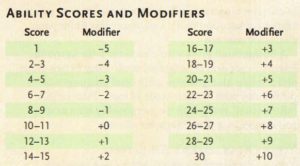Character Creation

Character Creation is the most important part of any Dungeons and Dragons campaign.
1. Choose A Race
2. Choose Your Class (characters vocation that provides certain advantages/disadvantages
3. Choose Level (consult your DM, typically this is set at level 1.
4. Determine Hit Dice and Determine your starting Hit points.
Your starting hit points at first level are the max of your hit die which is determined by your class + your constitution modifier. Record your character’s hit points on your character sheet. Also record the type of hit die your character has and the number of hit dice you have. After you rest, you can spend hit dice to regain hit points.
Proficiency Bonus: The table that appears in your class description shows your proficiency bonus, which is +2 for a 1st level character. Your proficiency bonus applies to many of the numbers you’ll be recording on your character sheet:
* Attack rolls using weapons you’re proficient with
* Attack rolls with spells you cast
* Ability checks using skills you’re proficient in
* Ability checks using tools you’re proficient with
* Saving throws you’re proficient in
* Saving throw DC’s for spells you cast
Your class determines your weapon proficiencies, your saving throw proficiencies, and some of your skill and tool proficiencies. Your background gives you additional skill and tool proficiencies, and some races give your more proficiencies. Be sure to note all of your proficiencies, as well as your proficiency bonus, on your character sheet.
 Generate your ability scores
Generate your ability scores
Roll 4 d6 and record the total of the highest three dice on a scrap of paper. Do this for a total of six times. Now assign one of each of these numbers to the ability of your choice.
As an alternative you can use the following numbers: 15, 14, 13, 12, 10, 8.
After assigning, determine you ability modifiers using the chart below or take your ability score, subtract 10, divide by 2 (round down). Write the modifiers on the character sheet.
Figure out your personality and background. Choose you alignment, ideals, bonds, and flaws. You would also create background information on where your character is from and what got them to this point in time that they are going out on an adventure.
Purchase weapons’, armor and equipment from equipment list. Try to keep the weight to no more than you strength X 15.
Armor Class: Your Armor Class (AC) represents how well your character avoids being wounded in battle. Things that contribute to your AC include the armor you wear, the shield you carry, and your Dexterity modifier. Not all characters ear armor or carry shields, however.
Without armor or shield, your character’s AC equals 10+ his or her Dexterity modifier. Now add in the Armor AC if you have one.
Your Character needs to be proficient with armor and shields to wear and use them effectively, and your armor and shield proficiencies are determined by your class. There are drawbacks to wearing armor or carrying a shield if you lack the proficiency.
Some spells and class features give you a different way to calculate your AC. If you have multiple features that give you a different way to calculate your AC, you choose which one to use
Weapons: For each weapon your character wields, calculate the modifier you use when you attack with the weapon and the damage you deal when you hit.
When you make an attack with a weapon, you roll a d20 and add your proficiency bonus (but only if you are proficient with the weapon) and the appropriate ability modifier.
For attacks with melee weapons, use your strength modifier for attack and damage rolls. A weapon that has the finesse property, such as a rapier, can use your Dexterity modifier instead.
For attacks with ranged weapons’, use your dexterity modifier for attack and damage rolls. A melee weapon that has the thrown property, such as a handaxe, can use your Strength modifier instead.